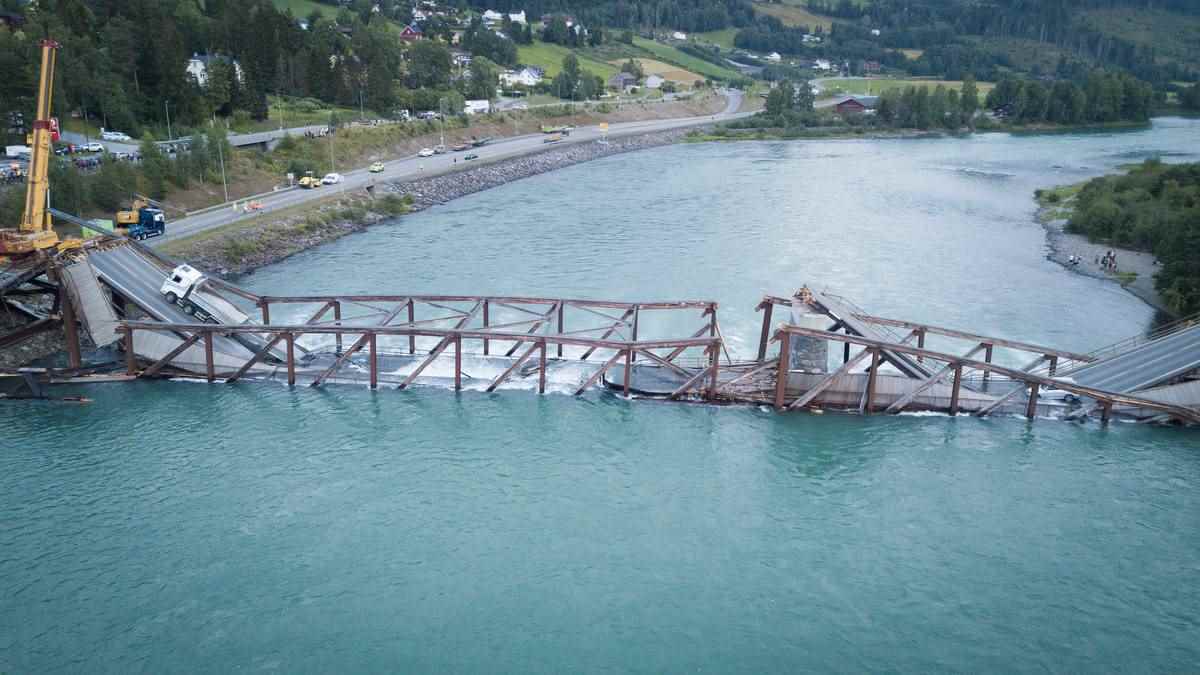On 15 August, the ten-year-old bridge at Tretten in Gudbrandsdalen collapsed. Large parts of the construction sailed down the river, while other parts were gradually dismantled. It became clear early on that this would result in a record amount of waste. Most of this was dangerously creosote-laced wood. The AF group, commissioned by Innlandet County Council, has made calculations that show the volume of waste this has led to so far. 193 tonnes of metal and 2 tonnes of plastic have been delivered for recycling. But the largest amount comes from the creosote-containing wood that broke like matches during the bridge collapse. A total of 437 tonnes of wood has been recycled at Solør Bioenergi in Innlandet. – Our biggest delivery Managing director Hans Moss says that this is the biggest single delivery they have ever had, if you ignore disused railway sleepers. Managing director Hans Moss at Solør Bioenergi. Photo: Private – The collapse of the building is a sad event, but the energy from here corresponds to approx. 1.6 GWH. This means that we have recovered the amount of energy that 75 detached houses use per year, says Moss. The combustion of wood at Solør Bioenergi provides both hot water for industrial production and electricity for ordinary consumers. Toxic gases If creosote-containing wood is burned in the open air, it creates toxic gases. The ovens in Solør filter and clean the wood during the process, so that no dangerous gases escape. Among other things, activated charcoal and lime are added to clean out toxic gases. Facts about creosote Creosote is a mixture of hundreds of different chemical substances that have a high content of tar substances. It has been used for impregnation to prevent rot since the 19th century. Creosote-treated wood has primarily been used in outdoor constructions such as bridges, railway sleepers and posts for telecommunications and electricity. In the first years of use, creosote-impregnated wood will “sweat out” creosote oil, especially on warm, sunny days. Creosote contains substances that are harmful to health and the environment. It contains carcinogenic substances and substances that are highly irritating to the skin. When the skin is exposed to creosote and sunlight, it can cause severe eczema, especially if the skin is exposed to it many times or over a long period of time. The Norwegian Environment Agency writes that direct skin contact with creosote-impregnated wood should be avoided. It is not permitted to use creosote-treated wood in playgrounds, nurseries, schools and other places where there is a risk of frequent skin contact. Source: Norwegian Environment Agency – We have a continuous measurement in the chimney that shows which components we emit. There are very strict requirements for maximum values and it is subject to a concession with an emission permit from the Norwegian Environment Agency, says Moss. 2 percent turns to ash. It is sent to a landfill on Langøyene by Holmestrand in Vestfold. A LOT OF ENERGY: Grinding of wood waste at Solør Bioenergi. Photo: Private – The treatment of this waste has so far cost NOK one million for the county municipality, says chief engineer Anders Fosse Skjåk in Innlandet county municipality. – There is still some waste that has not been sorted. Several bags of waste are still lying along the river. There is also a part of the evidence warehouse that the police and the Accident Investigation Board dispose of, he says. READY FOR RECYCLING: Large parts of the wooden structure were splintered during the bridge collapse at Tretten. Photo: Lars Erik Skrefsrud / news Will find the reason Tretten bridge was a so-called truss bridge made of glulam and steel. It was built by the Norwegian Road Administration in 2012 as part of the E6 Øyer–Tretten project. The National Accident Investigation Board is now investigating what could be the cause of the collapse of the only 10-year-old bridge. In February 2016, another glulam bridge collapsed, namely the Perkolo bridge at Sjoa in Gudbrandsdalen. At the time, an investigation committee was able to quickly determine that the utility collapse was due to a design error.
ttn-69
What has happened to the environmentally hazardous waste after Tretten Bru collapsed? – news Innlandet – Local news, TV and radio

